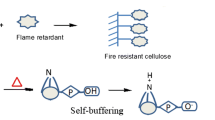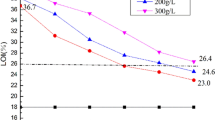Abstract
In this study, a novel flame retardant (FR) for cotton fabrics was synthesized, namely, ammonium salt of diethylenetriaminepenta(methylene-phosphonic acid) (ADTPMPA), using diethylenetriaminepenta(methylene-phosphonic acid) (DTPMPA) and urea, and its structure was comfirmed by 1H NMR, 13C NMR and 31P NMR. The ADTPMPA reacted with the –OH groups of cellulose macro molecules to form P–O–C covalent bonds. LOIs of cotton fabrics finished with 70 and 90 g/L ADTPMPA reached to 40.0 and 41.5% respectively; after 40 laundering cycles, their LOIs were 26.5 and 26.7% respectively. The treated cotton fabrics still kept soft. FTIR spectroscopy confirmed –P–O–C bonds between ADTPMPA and cellulose, and X-ray diffraction revealed the formation of cellulose II structures in the finishing process. SEM suggested that ADTPMPA molecule permeates the inner space of the cotton fibers. TG result indicated that the treated cotton fibers retain more residue than the original fibers. Cone calorimetry test result showed that the treated cotton fabric had lower PHRR and THR than that of original cotton fabric. The results suggested that the ADTPMPA treated cotton fabrics had condense phase flame retardant mechanism.






Similar content being viewed by others
References
Abou-Okeil A, El-Sawy SM, Abdel-Mohdy FA (2013) Flame retardant cotton fabrics treated with organophosphorus polymer. Carbohydr Polym 92:2293–2298
Alongi J, Malucelli G (2015) Cotton flame retardancy: state of the art and future perspectives. RSC Adv 5:24239–24263
Athauda TJ, LePage WS, Chalker JM, Ozer RR (2014) High density growth of ZnO nanorods on cotton fabric enables access to a flame resistant composite. RSC Adv 4:14582–14585
Bosco F, Casale A, Mollea C, Terlizzi ME, Gribaudo G, Alongi J, Malucelli G (2015) DNA coatings on cotton fabrics: effect of molecular size and pH on flame retardancy. Surf Coat Technol 272:86–95
Caschera Toro RG, Federici F, Riccucci C, Ingo GM, Gigli G, Cortese B (2015) Flame retardant properties of plasma pre-treated/diamondlike carbon (DLC) coated cotton fabrics. Cellulose 22:2797–2809
Chen SS, Li X, Li Y, Sun JQ (2015) Intumescent flame-retardant and self-healing superhydrophobic coatings on cotton fabric. ACS Nano 9(4):4070–4076
Costes L, Laoutid F, Brohez S, Dubois P (2017) Bio-based flame retardants: when nature meets fire protection. Mater Sci Eng R 117:1–25
Dhineshbabu NR, Manivasakan P, Karthik A, Rajendran V (2014) Hydrophobicity, flame retardancy and antibacterial properties of cotton fabrics functionalised with MgO/methyl silicate nanocomposites. RSC Adv 4:32161–32173
El-Shafei A, ElShemy M, Abou-Okeil A (2015) Eco-friendly finishing agent for cotton fabrics to improve flame retardant and antibacterial properties. Carbohydr Polym 118:83–90
Fang F, Chen XX, Zhang X, Cheng C, Xiao DZ, Meng YD, Ding X, Zhang H, Tian XY (2016) Environmentally friendly assembly multilayer coating for flame retardant and antimicrobial cotton fabric. Prog Org Coat 90:258–266
Gao WW, Zhang GX, Zhang FX (2015) Enhancement of flame retardancy of cotton fabrics by grafting a novel organic phosphorous-based flame retardant. Cellulose 22:2787–2796
Grancaric AM, Botteri L, Alongi J, Malucelli G (2015) Synergistic effects occurring between water glasses and urea/ammonium dihydrogen phosphate pair for enhancing the flame retardancy of cotton. Carbohydr Polym 22:2825–2835
Heinze T, Sarbova V, Nagel MCV (2012) Simple synthesis of mixed cellulose acylate phosphonates applying n-propyl phosphonic acid anhydride. Cellulose 19(2):523–531
Horrocks AR (2011) Flame retardant challenges for textiles and fibers: new chemistry versus innovatory solutions. Polym Degrad Stab 96:377–392
Huang GB, Liang HD, Wang X, Gao JR (2012) Poly (acrylic acid)/clay thin films assembled by layer-by-layer deposition for improving the flame retardancy properties of cotton. Ind Eng Chem Res 51:12299–12309
Jiang W, Jin FL, Park SJ (2015) Synthesis of a novel phosphorus-nitrogen-containing intumescent flame retardant and its application to fabrics. J Ind Eng Chem 27:40–43
Ke CH, Li J, Fang KY, Zhu QL, Zhu J, Yan Q (2011) Enhancement of a hyperbranched charring and foaming agent on flame retardancy of polymide 6. Polym Adv Technol 22(12):2237–2243
Kim MJ, Jeon IY, Seo JM, Dai LM, Baek JB (2014) Graphene phosphonic acid as an efficient flame retardant. ACS Nano 8(3):2820–2825
Leistner M, Abu-Odeh AA, Rohmer SC, Grunlan JC (2015) Water-based chitosan/melamine polyphosphate multilayer nanocoating that extinguishes fire on polyester-cotton fabric. Carbohydr Polym 130:227–232
Li YC, Schulz J, Mannen S, Delhom C, Condon B, Chang SC, Zammarano M, Grunlan JC (2010) Flame retardant behavior of polyelectrolyte clay thin film assemblies on cotton fabric. ACS Nano 4(6):3325–3337
Liang SY, Neisius NM, Gaan S (2013) Recent developments in flame retardant polymeric coatings. Prog Org Coat 76:1642–1665
Malucelli G, Bosco F, Alongi J, Carosio F, Blasio AD, Mollea C, Cuttica F, Casale A (2014) Biomacromolecules as novel green flame retardant systems for textiles: an overview. RSC Adv 4:46024–46039
Nguyen MM, Al-Abdul-Wahid MS, Fontenot KR, Graves EE, Chang SC, Condon BD, Grimm CC, Lorigan GA (2015) Understanding the mechanism of action of triazine-phosphonate derivatives as flame retardants for cotton fabric. Molecules 20:11236–11256
Pan H, Song L, Ma L, Pan Y, Liew KM, Hu Y (2014) Layer-by-layer assembled thin films based on fully biobased polysaccharides: chitosan and phosphorylated cellulose for flame-retardant cotton fabric. Cellulose 21:2995–3006
Poon CK, Kan CW (2015) Effects of TiO2 and curing temperatures on flame retardant finishing of cotton. Carbohydr Polym 121:457–467
Qi H, Li WL, Liu LY, Song WW, Ma WL, Li YF (2014) Brominated flame retardants in the urban atmosphere of Northeast China: concentrations, temperature dependence and gas-particle partitioning. Sci Total Environ 491–492:60–66
Shariatinia Z, Javeri N, Shekarriz S (2015) Flame retardant cotton fibers produced using novel synthesized halogen-free phosphoramide nanoparticles. Carbohydr Polym 118:183–198
Vasiljević J, Hadzić S, Jerman I, Cerne L, Tomsic B, Medved J, Godec M, Orel B, Simoncic B (2013) Study of flame-retardant finishing of cellulose fibres: organice–inorganic hybrid versus conventional organophosphonate. Polym Degrad Stab 98:2602–2608
Xu F, Yang YL, Zhang GX (2015) A self-stiffness finishing for cotton fabric with N-methylmorpholine-N-oxide. Cellulose 22:2837–2844
Yang ZY, Wang XW, Lei DP, Fei B, Xin JH (2012) A durable flame retardant for cellulosic fabrics. Polym Degrad Stab 97:2467–2472
You GY, Cheng ZQ, Tang YY, He HW (2015) Functional group effect on char formation, flame retardancy and mechanical properties of phosphonate-triazine-based compound as flame retardant in epoxy resin. Ind Eng Chem Res 54:7309–7319
Zheng DD, Zhou JF, Zhong L, Zhang FX, Zhang GX (2016) A novel durable and high-phosphorous-containing flame retardant for cotton fabrics. Cellulose 23:2211–2220
Acknowledgments
This work was supported by the Fundamental Research Funds for the Central Universities (Grant No. XDJK2013A021) and Innovation Project of Southwest University (Grant No. 100030-2120130626).
Author information
Authors and Affiliations
Corresponding author
Rights and permissions
About this article
Cite this article
Zheng, D., Zhou, J., Wang, Y. et al. A reactive flame retardant ammonium salt of diethylenetriaminepenta(methylene-phosphonic acid) for enhancing flame retardancy of cotton fabrics. Cellulose 25, 787–797 (2018). https://doi.org/10.1007/s10570-017-1543-z
Received:
Accepted:
Published:
Issue Date:
DOI: https://doi.org/10.1007/s10570-017-1543-z




